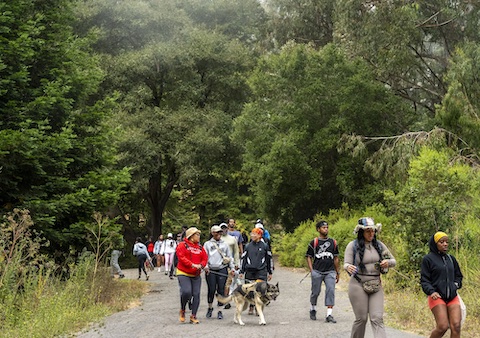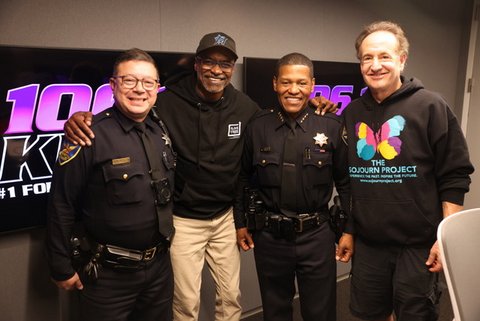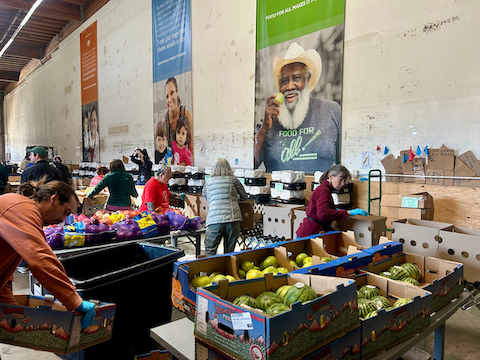
06 Aug New Senior Care Center Opens in El Sobrante

Tena Smith, left, and Janine Bouie listen to speeches at the opening of a new Program of All-Inclusive Care for the Elderly center in El Sobrante on Aug. 1. The center is operated by the Center for Elders’ Independence. (Andres Jimenez Larios / Bay City News)
By Andres Jimenez Larios
Bay City News
Attendees of the opening of El Sobrante’s new senior care center ate free food, got personal tours of the facility, and listened to local leaders commemorating the occasion.
The Center for Elders’ Independence on Friday opened a new PACE, Program of All-Inclusive Care for the Elderly, center on San Pablo Dam Road. The facility will assist approximately 400 individuals aged 55 years and older with their daily care routines by providing access to on-site medical teams, physical therapy, behavioral health services, and community-building activities.
PACE centers are regulated by the state and federal government and are required to have specific services for participants such as a dedicated clinic, transportation, rehabilitation, and coordinated care. The centers are intended for seniors who would otherwise reside in nursing facilities.
According to the California Department of Health Care Services, a person eligible to receive PACE services must be 55 years or older, reside in a PACE service area, be determined eligible at the nursing home level of care by the Department of Health Care Services, and be able to live safely in their home or community at the time of enrollment.
Maria Zamora, president and CEO of Center for Elders’ Independence, highlighted features of the new space that she said makes it one of the best facilities for people to receive continuous care as they age. She said the PACE center is built around having a comprehensive and “one stop shop” approach to care where aging individuals will be able to receive specialized attention from one place.
Senior care centers are not the same as a senior living community, said Zamora. The role of PACE and facilities like it is to help individuals and caretakers with the responsibilities associated with aging.
“When somebody enrolls in a PACE program, we really become responsible for all of their caring services. It’s the medical care, social care, it’s just about everything,” said Zamora. “The goal, intention and mission of PACE is to allow these older adults to live in their own homes and community with our supportive services wrapped around them.”
Zamora says the majority of residents at the centers they operate are low-income and use either Medicare or Medicaid to cover costs.
When asked if the recent cuts to parts of Medicare and Medicaid in the fiscal year 2025-2026 federal budget have affected the Center for Elders’s Independence, Zamora said they have plans in place that would draw money from non-governmental sources so services can continue, but the organization would still have to wait and respond to whatever specific changes are made into the law.
“There aren’t any cuts that are targeted specifically at PACE, so we will likely see a secondary impact of the other cuts. We’re still doing a lot of analysis on the bill to see how this might impact us,” said Zamora. “We’ve done some contingency planning with the best we could, but it really is kind of a wait and see.”
Staff at the center were excited to welcome new participants as they stood along the light blue wall accented by hardwood floors.
Jessenya Ramirez-Sacasa, El Sobrante’s center director, led tours throughout the facility and answered questions.
The center’s spiritual director Mi Chun said she was ready to help lead people of all faiths, or none, in community building programming.
Speeches were made by elected officials that all commemorated the importance of having a senior care facility in the local area.
“This is the largest growing demographic in our county and in our state, seniors, and unless we figure a way to do more of this and other supportive services, they’re not going to live the quality of life that they deserve, and they’re going to have to move away,” said Contra Costa County Supervisor John Gioia. “That’s not what we want. We want them to stay here, and which is why we support these types of projects and look for increased partnerships.”
“It’s more than a medical center, it’s a community center,” said Richmond Mayor Eduardo Martinez. “What I take most from this is the inclusiveness and how it invites us in, not to just seek medical care, but to be part of the community.”
One participant, Tracy Noble, spoke about the positive experience she has had at PACE centers. She recommended participating in the center’s services for people who are looking for regular and reliable care at an older age, but want to stay in their homes and not reside in a senior community center.
“I just wanted to say I really appreciate the opportunity to be able to come here once a week to see people, to have the same people and same things I need,” said Noble. “I would be traveling over to Concord, but now there is this local one.”
According to projections from the California Department of Finance, the number of people in Contra Costa County ages 65 or older is expected to rise by 71% by 2040 compared to the numbers in 2020.
Copyright © 2025 Bay City News, Inc. All rights reserved. Republication, rebroadcast or redistribution without the express written consent of Bay City News, Inc. is prohibited. Bay City News is a 24/7 news service covering the greater Bay Area.






No Comments